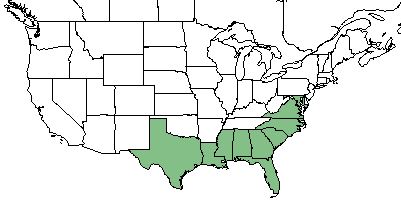Difference between revisions of "Desmodium fernaldii"
(→Description) |
|||
| Line 25: | Line 25: | ||
==Description== | ==Description== | ||
<!-- Basic life history facts such as annual/perrenial, monoecious/dioecious, root morphology, seed type, etc. --> | <!-- Basic life history facts such as annual/perrenial, monoecious/dioecious, root morphology, seed type, etc. --> | ||
| − | ''D. fernaldii'' is a perennial forb/herb of the ''Fabaceae'' family native to North America. <ref name= "USDA Plant Database"> USDA Plant Database [https://plants.usda.gov/core/profile?symbol=DEFE https://plants.usda.gov/core/profile?symbol=DEFE] </ref> Leaves alternate, trifoliate and pinnately shaped, ovate leaflets, and stipules deltate. Inflorescence is terminal and can be unbranched or branched. Flower has purple corolla with lobes either equal or slightly longer than the tube. Fruits sinuate above in segments between 2 and 5, and convex above, angled below.<ref name= "Woods">Woods, M. (2008). "The genera Desmodium and Hylodesmum (Fabaceae) in Alabama." Castanea 73(1): 46-69.</ref> | + | ''D. fernaldii'' is a perennial forb/herb of the ''Fabaceae'' family native to North America. <ref name= "USDA Plant Database"> USDA Plant Database [https://plants.usda.gov/core/profile?symbol=DEFE https://plants.usda.gov/core/profile?symbol=DEFE] </ref> Leaves alternate, trifoliate and pinnately shaped, ovate leaflets, and stipules deltate. Inflorescence is terminal and can be unbranched or branched. Flower has purple corolla with lobes either equal or slightly longer than the tube. Fruits sinuate above in segments between 2 and 5, and convex above, angled below. Roots are perennial.<ref name= "Woods">Woods, M. (2008). "The genera Desmodium and Hylodesmum (Fabaceae) in Alabama." Castanea 73(1): 46-69.</ref> |
==Distribution== | ==Distribution== | ||
Revision as of 14:03, 25 April 2019
Common name: Fernald's Ticktrefoil [1]
| Desmodium fernaldii | |
|---|---|
| Scientific classification | |
| Kingdom: | Plantae |
| Division: | Magnoliophyta - Flowering plants |
| Class: | Magnoliopsida - Dicots |
| Order: | Fabales |
| Family: | Fabaceae |
| Genus: | Desmodium |
| Species: | D. fernaldii |
| Binomial name | |
| Desmodium fernaldii G.B. Schub | |

| |
| Natural range of Desmodium fernaldii from USDA NRCS Plants Database. | |
Contents
Taxonomic Notes
Synonyms: Meibomia rhombifolia Vail
Varieties: none
Description
D. fernaldii is a perennial forb/herb of the Fabaceae family native to North America. [1] Leaves alternate, trifoliate and pinnately shaped, ovate leaflets, and stipules deltate. Inflorescence is terminal and can be unbranched or branched. Flower has purple corolla with lobes either equal or slightly longer than the tube. Fruits sinuate above in segments between 2 and 5, and convex above, angled below. Roots are perennial.[2]
Distribution
D. fernaldii can be found along the southeastern coast of the United States from Texas to Maryland. [1]
Ecology
Habitat
D. fernaldii proliferates in sandhills, dry flatwoods, and woodland borders. [1] Specimens have been collected from open sand ridge, annually burned upland pineland, loamy sands of pine-oak woodland, and longleaf pine woods. [3] It prefers shade to part shade, and dry soil moisture.[4] In Alabama, it is uncommon but can be found in open woodlands, sandhills, old fields, and roadsides.[2]
Phenology
Flowering time of D. fernaldii is between June and September.[5] It has been observed to flower in October. [6]
Conservation and Management
Cultivation and restoration
Photo Gallery
References and notes
- ↑ 1.0 1.1 1.2 1.3 USDA Plant Database https://plants.usda.gov/core/profile?symbol=DEFE
- ↑ 2.0 2.1 Woods, M. (2008). "The genera Desmodium and Hylodesmum (Fabaceae) in Alabama." Castanea 73(1): 46-69.
- ↑ URL: http://herbarium.bio.fsu.edu. Last accessed: June 2018. Collectors: A.F. Clewell, Loran C. Anderson. States and counties: Florida (Leon, Escambia) Georgia (Thomas)
- ↑ [[1]] Lady Bird Johnson Wildflower Center. Accessed: April 25, 2019
- ↑ Weakley, A. S. (2015). Flora of the Southern and Mid-Atlantic States. Chapel Hill, NC, University of North Carolina Herbarium.
- ↑ Nelson, G. PanFlora: Plant data for the eastern United States with emphasis on the Southeastern Coastal Plains, Florida, and the Florida Panhandle. www.gilnelson.com/PanFlora/ Accessed: 21 MAY 2018